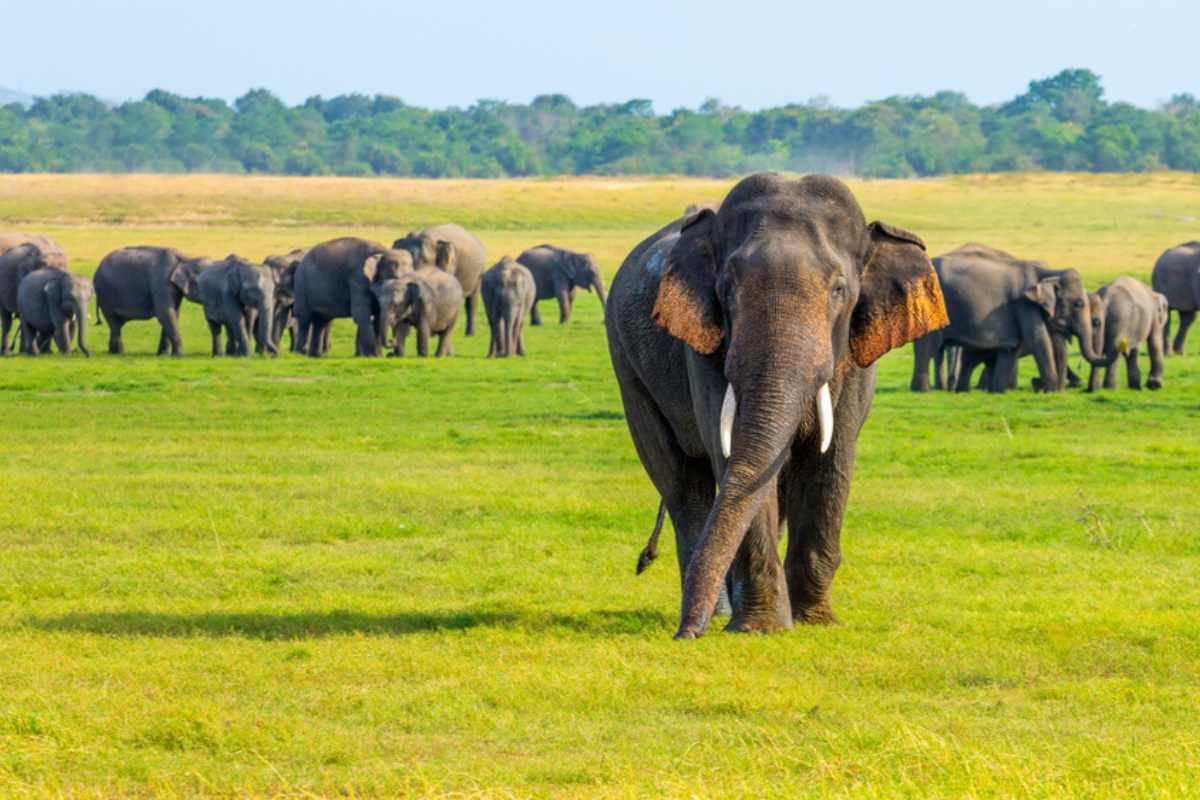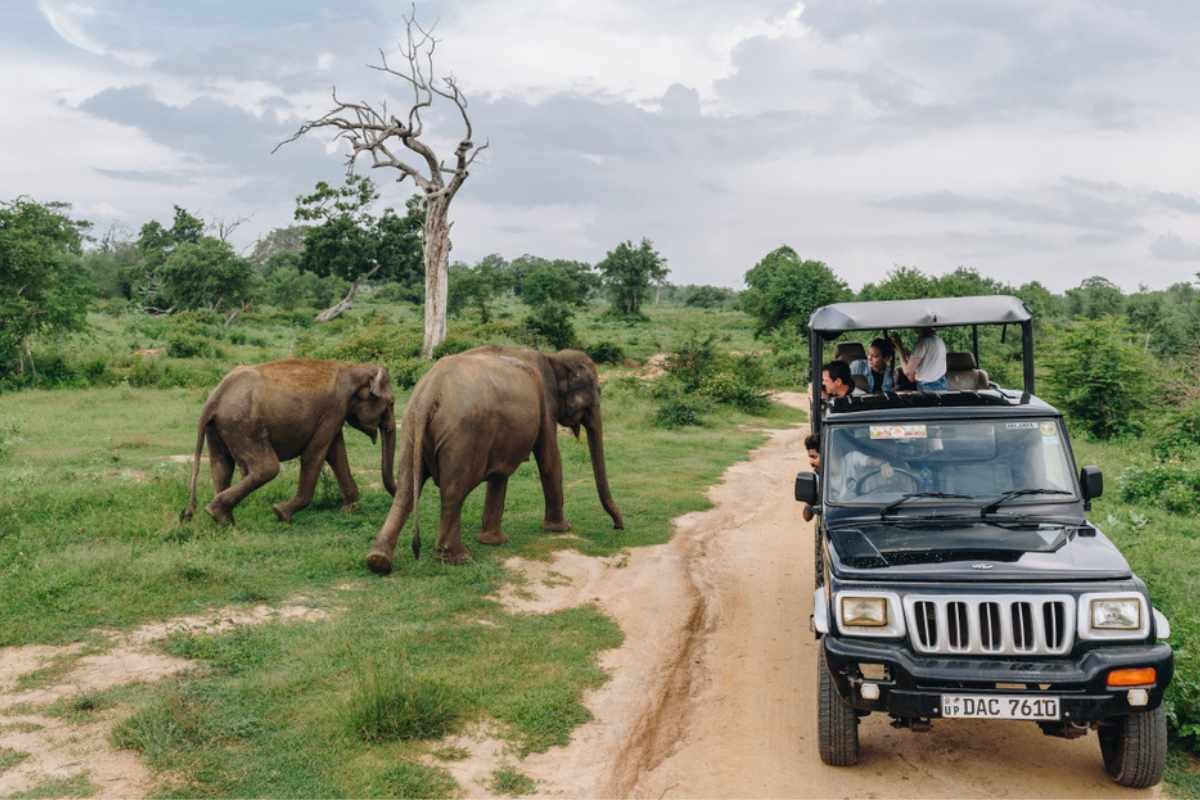
The Sri Lankan elephant, a subspecies of the Asian elephant, is a majestic and significant part of the island’s wildlife. With a population of approximately 6,000, these elephants are notable for being Asia’s largest and darkest of their kind. They are easily recognized by the distinctive depigmentation on their ears, face, trunk, and belly.
Scientific Name: Elephas maximus maximus
Physical Characteristics:
- Height: 8-10 feet at the shoulder
- Weight: Ranges between 4,400 and 12,000 pounds
Behaviour: The herd, usually comprising 12-20 individuals, is led by a matriarch. The social structure includes nursing units (lactating females and their young) and juvenile care units (females with juveniles).
Habitats and Viewing Locations
Geographical Spread
Primary Habitats: Sri Lankan elephants are predominantly found in the lowland areas of the dry zone. This includes regions in the north, south, east, north-western, north-central, and south-eastern parts of Sri Lanka.
Peak Wilderness Sanctuary: A smaller yet significant population of these elephants resides in the Peak Wilderness Sanctuary, offering a unique habitat for them.
Absence in Certain Areas: Notably, Sri Lankan elephants are absent from the wet zone of the country. This distinction in habitat preference is crucial for understanding their ecological needs and patterns.
Protected Areas for Elephant Viewing: Sri Lanka boasts several national parks renowned for their elephant populations, offering unique opportunities for wildlife enthusiasts to observe these majestic creatures. Here are some of the most popular national parks for elephant viewing:
Yala National Park: One of the most famous wildlife parks in Sri Lanka, Yala is known for its variety of animals, but it’s trendy for elephant sightings. The park has a substantial elephant population; visitors often see them roaming in their natural habitat.
Udawalawe National Park: Udawalawe park rivals the African savannah for elephant sightings. It’s home to a large herd of resident elephants, and visitors can frequently spot these animals around the Udawalawe Reservoir. The park also hosts an Elephant Transit Home, which cares for orphaned elephant calves.
Minneriya National Park: Famous for the ‘Minneriya Elephant Gathering,’ this park is a hotspot during the dry season (July to September) when elephants gather around the Minneriya reservoir. This gathering is one of the most impressive natural phenomena in Sri Lanka, where large herds of elephants can be seen.
Kaudulla National Park: Located close to Minneriya, Kaudulla also witnesses an elephant gathering, typically between August and December. It’s part of an elephant corridor that elephants use to migrate between nearby forests.
Wasgomuwa National Park: Known for its significant elephant population, Wasgomuwa offers a more off-the-beaten-path experience for elephant viewing. The park’s elephants are known for being less habituated to humans, offering a wilder experience.
Wilpattu National Park: Although more famous for leopards, Wilpattu also has a healthy population of elephants. The dense forest and numerous villus (natural lakes) provide a perfect habitat for elephants.
For those seeking in-depth information about national parks in Sri Lanka and guidelines for responsible and respectful elephant viewing, the Sri Lanka Travel Pages website is an invaluable resource. Link
Other Protected Areas: The size of many protected areas varies, with some being less than 1,000 km² and others even smaller than 50 km². These areas may not encompass the entire home ranges of the elephants, but they still provide critical refuges.
Mahaweli Development Area: This area includes several critical national parks, such as Flood Plains National Park, and Somawathiya National Park. These parks play a vital role in conserving Sri Lankan elephants and offer additional locations for wildlife enthusiasts to observe these magnificent creatures.
Best Practices for Elephant Viewing
When observing elephants in Sri Lanka’s national parks, it’s crucial to follow best practices to ensure a safe and respectful experience for both the visitors and the elephants.
Maintain a Safe Distance: Always keep a safe distance from the elephants. They are wild animals and can be unpredictable.
Do Not Disturb: Avoid making loud noises or sudden movements that might disturb the elephants.
Stay in the Vehicle: In parks where safari vehicles are used, always remain inside the Vehicle.
Follow Park Guidelines: Adhere to all park rules and guidelines provided by your guide or park authorities.
Seasonal and Geographical Tips
The dry season (typically from July to September) is often the best time for elephant viewing, especially in parks like Minneriya, where the famous ‘Elephant Gathering’ occurs.
Water Sources: Elephants often congregate near water sources, so visiting these areas can increase your chances of sightings.
Different Parks, Different Experiences: Each park offers a unique environment and elephant behaviour—research or consult guides to choose the best park for your interests.
Benefits of Using the Guide
Enhanced Experience: An informative guide helps you understand the behaviour and habitat of elephants, enhancing your viewing experience.
Planning: Knowledge of seasonal variations and park features assists in planning your visit for optimal elephant sightings.
Learn About Elephants: Guides provide valuable information about the life and habits of Sri Lankan elephants, contributing to a more meaningful experience.
Supporting Conservation
Economic Support: Visiting national parks and engaging in responsible tourism supports conservation efforts financially.
Awareness: Educated tourists are more likely to support and advocate for elephant conservation efforts.
Community Involvement: Many parks have community involvement programs that benefit the local population and wildlife conservation.
Supporting Research and Conservation Programs: Park fees often go towards conservation research and initiatives.
By adhering to these best practices, visitors can ensure their elephant-viewing experiences are enjoyable and sustainable, positively conserving these magnificent creatures and their habitats.
Conservation Status
The population of Sri Lankan elephants has experienced a significant decline, decreasing by nearly 65% since the early 19th century. This drastic reduction highlights the challenges faced by the species in terms of habitat loss, human-elephant conflict, and other environmental pressures.
Legal Protection
Sri Lankan Law: In response to the declining numbers and the critical need for conservation, Sri Lankan elephants are now rigorously protected under the laws of Sri Lanka.
Penalties for Harm: There are stringent penalties for harming these elephants, emphasizing the seriousness with which conservation efforts are taken. The legal framework aims to deter poaching, habitat destruction, and other harm that threaten the species.
Implications for Conservation
Focus on Preservation: Legal protection is a vital step towards ensuring the survival of these majestic animals. It underscores the commitment to preserving the elephants and their natural habitats.
Role of Conservation Programs: Various conservation programs and initiatives are essential alongside legal protection. These programs often involve community engagement, habitat restoration, elephant behaviour and ecology research.
International Support: The conservation of Sri Lankan elephants also benefits from international support and collaboration, especially in funding, expertise, and global awareness campaigns.
The Sri Lankan elephant is vital to the island’s natural heritage. Conservation efforts and responsible tourism are crucial to ensuring their survival and well-being. Visitors can witness these magnificent creatures in their natural habitat, contributing to their conservation and the local economy.
Article by
Ravindu Dilshan Illangakoon
As co-founder and Head of Content at Sri Lanka Travel Pages, I ensure that every blog post we publish is AMAZING.


